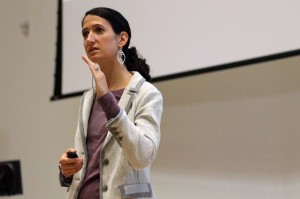
A study by biologist Kelly Hogan shows that when a traditional lecture course was made more interactive, the achievement gap disappeared for first-generation students and decreased by half for black students. (photo by Mary Lide Parker)
In large college science classes, active learning interventions improve achievement for everyone, but especially black and first-generation students, according to a new study from the University of North Carolina at Chapel Hill.
When a traditional lecture course was structured to be more interactive, the achievement gap disappeared for first-generation students and decreased by half for black students, according to Kelly Hogan, a biologist and director of instructional innovation in UNC’s College of Arts and Sciences. Transforming large lecture classes is a priority for the college.
Hogan was invited to a September 2014 White House summit on science, technology, engineering and mathematics (STEM) education.
Her study, “Getting Under the Hood: How and for Whom Does Increasing Course Structure Work?” appeared Sept. 2 in the journal CBE-Life Sciences Education. Her co-author is Sarah L. Eddy of the University of Washington in Seattle. The two collected data over six semesters at UNC.
The study, featured in The New York Times,The Washington Post and elsewhere, compares student achievement in classes with “low course structure” to those with “higher course structure.” Low course structure is “a traditional classroom where students come in, listen to the instructor, leave and don’t do anything until the night before the exam,” Hogan said. Higher course structure adds guided reading questions, preparatory homework and in-class activities that reinforce major concepts, study skills and higher-order thinking skills. As an example of an in-class activity, students answered questions using classroom-response software on their laptops and cellphones.
Students are held accountable for the assignments— they are awarded points for being prepared and participating in class.
“If I’m talking at students, they’re shopping, they’re on ESPN or Facebook,” Hogan said. “But if I ask them a question and have them wrestle with it, they are listening now because they are engaged in solving that problem.”
Hogan’s study is one of the few college-level studies to separate student data by racial/ethnic groups and first-generation status to identify which interventions work best for certain groups of students in a large STEM course.
The researchers used surveys at the end of the course to learn how the interventions affected student behaviors and attitudes.
“We found that in the higher course structure, students consistently reported completing the assigned readings more frequently and spent more time studying for class, and there was an increased sense of community,” Hogan said.
Their study also demonstrates that active learning interventions can be transferrable from a Pacific Northwest research university to a Southern research university across three contexts: different instructors, different student populations and different courses (majors vs. nonmajors).
“This is good evidence that an intervention is transferrable, and I think that’s going to be powerful for a lot of teachers in the field,” Hogan said.
More instructors are “flipping” their classes — putting lectures online for students to watch at home and using the classroom for more interactive, collaborative work. But if a class is not flipped with accountability, Hogan said, the students still won’t come to class prepared.
Hogan outlines three key takeaways for instructors that are critical for understanding how to increase student success in large lecture classes:
- Students are not a monolithic group.
- Accountability is essential for changing student behaviors and possibly grades.
- Survey questions are a useful method of identifying what behaviors an instructor might target to increase student performance.
“The message I want to get out to teachers is, ‘go for it,’” Hogan said. “An individual teacher can make a difference.”
The study was supported by grants from the National Science Foundation and the Center for Faculty Excellence at UNC. A link to the study online is available here: http://www.lifescied.org/content/13/3/453.full.
For stories and videos featuring Hogan’s innovation in large lecture classes, visit http://tinyurl.com/m97nyby and http://tinyurl.com/klhpwda.
